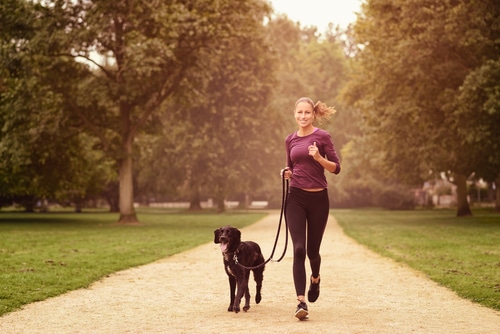A tired dog is (usually) a good dog. Every pup needs a physical outlet to use up energy and maintain health and fitness, no matter what size they are. Dogs, particularly puppies and young dogs have lots of energy and if they don’t get a chance to burn it off, will often turn destructive in their behaviour.
So if you find that you are constantly having to replace shredded pillows or you are becoming increasingly annoyed at all the holes your dog is digging in the garden, there’s a good chance they’re not getting enough exercise.
The good news is that keeping your dog healthy, happy and out of trouble with daily exercise is a lot of fun and provides many benefits, including:
- Helps to reduce or eliminate common behavioural problems such as digging, barking, chewing and hyperactivity
- Helps to keep dogs healthy
- Helps to reduce digestive problems and constipation
- Helps timid or fearful dogs build confidence and trust
- Helps dogs feel sleepy, rather than restless, at bedtime or when you’re relaxing
- Helps to keep dogs’ weight under control
How much exercise does my dog need?
There is no way to work out exactly how much exercise a dog needs. It depends on a number of factors including their age, breed and health. In general, dogs in the hunting, working or herding groups (i.e. collies, hounds and labradors) will need more exercise than most other breeds. If your dog is in one of these groups and is in good health, they should be getting at least 30 minutes of rigorous exercise along with 1-2 hours of daily activity. Some toy dogs such as Chihuahuas will only thrive on short walks, while other smaller dogs such as various terrier types will be full of beans and need a considerable amount of time outside. When trying to ascertain how much exercise your dog might need, looking into their breed history and general activity levels can be a big help.

Letting your dog out into the garden a couple of times a day to go to the toilet is not enough! However small your dog is, you should assign at least half an hour a day to their walks – this is the absolute lowest limit of the amount of time that any dog needs to stay fit and healthy, but for the vast majority of dogs, half an hour a day simply won’t cut it.
Age and health
Older dogs are naturally less active than younger dogs and are more likely to suffer from stiff joints and various other problems that come with old age so too much exercise can actually become a chore for them. There is a fine line between keeping your older dog fit and overdoing it, and so you should consider your dog’s age and any health issues carefully as part of working out their exercise regime. If your dog is no longer fit enough to manage long, energetic walks, try breaking down their walks into several shorter walks over the course of the day instead.

Weight issues
Weight and exercise can be a bit of a catch 22 with dogs. Being overweight means that a dog is less able to exercise but at the same time, it’s all the more important to get them moving to burn off some of those extra pounds! Using exercise in combination with dietary changes is an important part of managing your dog’s weight. As with older dogs or those with health issues, be careful about pushing your overweight dog into high-energy activities and really long walks as it can cause even more problems. Again, try breaking your dogs day up into shorter walks instead of just one long walk.

Activities
Once you and your dog get in the habit of exercising daily, it can become a fun habit for both of you – and something which they won’t let you give up on easily! Dogs also make the best workout buddies. They never complain, or cancel on you last-minute. There are a variety of different ways to wear out an energetic dog (and get some exercise yourself). Obviously going for walks and playing fetch is a brilliant way to exhaust a dog (and using a tennis racket to throw the ball is even better) but a good brain game can almost be as tiring as a long hike too.

Get your dog to search for bits of food or treats hidden throughout the house or play a game of hide and seek. Hide in spots throughout the house and call him to you. This can also help with recalls too. Have several people hiding and take turns calling him and be sure to have a reward for him when he finds you. Using the stairs is also a great way to tire out your dog. The steps add an additional challenge to a dog’s workout as it uses different muscles than those used on a regular walk or run. Stand at the top of the stairs and throw a toy down to your dog. When your dog grabs the toy, call his name and have him bring the toy to you. After several rounds of this, he is sure to be worn out! Whatever you do, be consistent and make activities fun, not a chore. Exercise is as much about your dog’s well-being as bonding with your companion.


